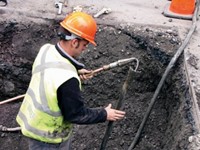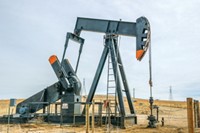Advertisement
Grab your lab coat. Let's get started
Welcome!
Welcome!
Create an account below to get 6 C&EN articles per month, receive newsletters and more - all free.
It seems this is your first time logging in online. Please enter the following information to continue.
As an ACS member you automatically get access to this site. All we need is few more details to create your reading experience.
Not you? Sign in with a different account.
Not you? Sign in with a different account.
ERROR 1
ERROR 1
ERROR 2
ERROR 2
ERROR 2
ERROR 2
ERROR 2
Password and Confirm password must match.
If you have an ACS member number, please enter it here so we can link this account to your membership. (optional)
ERROR 2
ACS values your privacy. By submitting your information, you are gaining access to C&EN and subscribing to our weekly newsletter. We use the information you provide to make your reading experience better, and we will never sell your data to third party members.
Environment
Improving Infrastructure To Cut Methane Emissions
Modernization of U.S. natural gas pipelines is reducing leaks and promoting safety
by Matt Davenport
October 26, 2015
| A version of this story appeared in
Volume 93, Issue 42

Natural gas is coursing through more than 2 million miles of distribution pipelines within the U.S. These carry gas that is tapped from large transmission pipelines into local homes and businesses.
Although distribution lines keep most of that fuel where it ought to be, Robert B. Jackson of Stanford University is interested in the gas that leaks from pipelines.
His reasons are threefold. For one, this gas is composed primarily of methane, meaning leaks contribute a potent greenhouse gas to the atmosphere. Second, escaped gas is lost product. One estimate valued it at more than $2 billion in 2013. Lastly, natural gas leaks can create deadly hazards.
A leaky cast-iron pipeline that predated the Great Depression led to an explosion in Allentown, Pa., that killed five people and destroyed eight homes in 2011. In response, the secretary of transportationand the federal Pipeline & Hazardous Materials Safety Administration (PHMSA) called for states to accelerate the replacement of outdated and unsafe pipelines.
Since 2011, Jackson and his team have covered more than 4,000 miles of city streets in eastern U.S. cities measuring methane leaks from pipelines with a car-mounted cavity ring-down spectrometer. They found that pipeline replacement programs are reducing leaks and natural gas emissions, but some cities are still lagging when it comes to modernizing their infrastructure (Environ. Sci. Technol. Lett. 2015, DOI: 10.1021/acs.estlett.5b00213).
“The biggest surprise is how much of a difference these replacement projects make,” Jackson tells C&EN. “It’s really a good-news story.”
The vast majority of America’s natural gas is carried to households by pipes made with modern materials, including robust plastics and steel that’s electrochemically protected against corrosion. Less than 3% of the country’s natural gas distribution pipelines are made of cast or wrought iron, according to a PHMSA database.
Still, that equates to nearly 30,000 miles of iron pipe still in place in the U.S. Unprotected steel pipelines account for almost another 100,000 miles, according to the PHMSA data. These pipelines are largely leftover from earlier years of U.S. natural gas infrastructure, with some dating back to the late-19th century, Jackson says. He and his coworkers consider pipes made with these older materials, which are capable of corroding, good candidates for replacement.
Gas distribution utilities in Durham, N.C., and Cincinnati have invested in replacing outdated materials quickly, and as a result, these cities harbor far fewer leaks per mile than Boston, New York City, and Washington, D.C., Jackson says.

The Stanford researchers also found that the latter three cities had a significantly higher percentage of pipes that they considered replacement candidates than did Durham—which has completed its pipeline replacement program—or Cincinnati. Cincy is on track to fully modernize its main distribution lines this year, although smaller service lines running to households may take until 2020 to update, Jackson’s team predicts. The researchers estimate that New York’s replacement program could take from two to five decades to complete if current trends hold steady.
“We’re glad to see the attention brought to outdated pipelines,” says David McCabe, an atmospheric scientist with the Clean Air Task Force, an advocacy group working to reduce greenhouse gas emissions and other air pollution. “We’re also glad to see credit where credit is due for the cities that are accelerating replacement.”
McCabe, who was not involved with Jackson’s study, commends the Stanford team for their thorough methodology, which included isotopic analysis of the gas to support the conclusion that it came from pipelines. Through carefully constructed surveys and analysis of publicly available data, the researchers showed outdated materials were responsible for higher gas leak rates, McCabe says.
But pipeline safety, rather than age, should be the guiding metric for which pipe is replaced first, says Pamela A. Lacey, senior managing counsel at the American Gas Association, a trade association representing companies that transport natural gas. And age and safety don’t necessarily go hand in hand, she says.
For instance, a small leak in a newer pipeline that lets gas collect in an enclosed space could be more dangerous than a larger leak from an older pipe in an open area, she explains. PHMSA and state agencies monitor and grade pipeline leaks on the basis of their safety risk.
Members of the American Gas Association have prioritized their pipeline replacements by safety thus far and it has worked well, she tells C&EN. “Since 1990, they’ve increased the number of miles of pipe in the ground by 30% to serve 30% more customers,” she says. “But emissions have dropped by 17%, and that’s because our members are modernizing their systems.”
“No one is suggesting that we deprioritize safety,” McCabe responded. “But you have to be concerned with any continuous leaks.”
Both McCabe and Lacey agree that now is an opportune time to push forward with modernization, but there are obstacles. For one, digging up old pipeline is expensive, disruptive, and potentially dangerous. And various states work differently with local distribution companies to handle the replacement efforts.
Consider the example of Cincinnati. Duke Energy is managing the accelerated main pipeline replacement program in the city and neighboring areas, which is scheduled to be completed this month. Duke launched this program 15 years ago, meaning it preceded the PHMSA call to action by more than a decade.
Duke invested $1 billion to replace more than 1,200 miles of gas mains. By working with the state-run Public Utilities Commission of Ohio, the company was able to recover some funds through modest additional charges that showed up on consumers’ monthly utility bills, says Duke spokeswoman Sally M. Thelen.
Currently, 39 states and the District of Columbia have similar programs that foster accelerated pipeline replacement programs, according to Lacey of the gas association. Some states, such as Vermont, have already completed their replacement programs. Others have built their infrastructures recently enough that upgrades are unnecessary.
But not all replacement programs are as effective as they could be. That’s something that Stanford’s Jackson would like to change. And he’s already seen some success.
For instance, as a direct result of his work, the Massachusetts state legislation passed a bill last year that allows companies to more quickly recover costs with help from consumers, he tells C&EN (Proc. Natl. Acad. Sci. USA 2015, DOI: 10.1073/pnas.1416261112). Each household would pay an estimated extra $1.00 to $2.00 a month on a gas bill.
“I think that’s an excellent outcome, and ultimately, it will save ratepayers money,” Jackson says. Gas companies are already charging their customers for the gas that leaks from pipelines and could continue to do so until the leaks stop, he explains. “We should invest in infrastructure now to reap the savings later.”
FUGITIVE EMISSIONS
Improvements at landfills can thwart escape of methane
The microscopic organisms decomposing waste in landfills are the third-largest emitters of methane in the U.S., trailing only oil and gas systems and livestock, according to Environmental Protection Agency estimates. For this reason, EPA has recently proposed new rules aimed to further restrict methane emissions from landfills.

\
Research suggests that there’s a lot more garbage going into landfills than officials previously thought (Nat. Clim. Change 2015, DOI: 10.1038/nclimate2804). The sites responsible for accepting newly-generated waste—as opposed to sites that just hold old waste—are also responsible for more than 90% of the country’s landfill methane emissions, the study says.
Americans dumped more than 260 million metric tons of garbage into landfills in 2012, compared with the 122 million metric tons estimated by EPA for the same year, according to the new report. But people shouldn’t get hung up on the discrepancy, says one of the study’s leaders, Jon T. Powell of Yale University’s department of chemical and environmental engineering.
Rather, he stresses that EPA’s estimates relied on a different method and that the data now exist to refine old assumptions and better inform waste management practices and policies.
In a statement to C&EN, EPA says that the new study accounts for all the waste material going to landfill, while the agency’s estimates for 2012 only included a portion of this. EPA also says that although the new study uses some data collected while Powell was a subcontractor for the EPA Office of Research & Development, the agency did not directly fund or guide the research.
The study emphasizes that landfill engineering practices could help mitigate methane emissions, Powell says. He and his colleagues examined more than 800 closed and active landfills around the U.S. with gas collection systems.
These gas collection systems operate most effectively at closed landfill sites, which are not accepting new waste and are sealed with capping systems, such as thick layers of plastic called geomembranes. Open landfills—sites that are accepting waste—thus become logical targets for near-term methane emission reductions, Powell says.
“The issue of fugitive methane emissions from landfills is well-known,” says Morton A. Barlaz, head of the department of civil, construction, and environmental engineering at North Carolina State University. Barlaz, who was not involved with the new study, adds, “The methods used to estimate collection efficiency are imprecise, but the finding that most methane emissions result from open landfills certainly makes sense.”
Because open landfills may not be capped, there are many areas inside where methane collection is difficult or inefficient, Powell explains. But there is not a one-size-fits-all solution to improve methane collection, he adds. “It’s a site-specific engineering problem.”
Solutions to these site-specific problems, combined with EPA’s recently proposed rules, would help lower landfill methane emissions, Powell says.
The new data will allow researchers and policy-makers to look holistically at the problem of landfill emissions and overall landfill management, he says, to try to answer the all-important question: “How can we do better?”





Join the conversation
Contact the reporter
Submit a Letter to the Editor for publication
Engage with us on Twitter